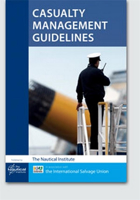Set of two publications (can be purchased seperately)
1) Casualty Management Guidelines:
Casualties are not straightforward and mariners who find themselves involved in them rarely have previous experience. The Nautical Institute and the International Salvage Union have produced these comprehensive practical guidelines to help seafarers during a casualty when demands can be confusing, contradictory, unclear or a combination of all three. Masters and crew members are told what to expect from people or organisations that might be involved as the casualty unfolds.
Chapters within Casualty Management Guidelines are presented in a largely chronological order of how Masters should expect to deal with different people, from owners to government officials, insurance representatives and salvage experts. It will give all involved an idea of the job each may be undertaking, together with priorities and responsibilities.
"This book should be on every vessel, and in every shipping company. It will not prevent casualties, but it will most certainly make them easier to deal with, and we give it our highest recommendation"
International Tugmasters Association
Published: 2012
2) Navigation Accidents and Their Causes:
Navigation Accidents and their Causes looks at major casualties to illustrate the lessons that can be learned from them and sets out practical ways for those on the bridge to consider risks, plan for them and then take action to avoid them.

























